K.M. Alexander's Blog, page 40
September 24, 2018
Choosing Time
Most “rules” for writing are hyper-personal. What works for one writer will not work for another writer. We each discover our own path in the journey of creation and each path is as different as the person who walks it. But there is one bit of advice that remains true regardless of our course: to become a writer, you have to write.
That is a choice in itself. It doesn’t matter what we desire to do, if you’re driven to create then you have to participate in that act of creation. What you’re doing at that moment isn’t choosing to write but choosing the time to write. Time is the currency for creation. That applies to every creator working in any medium and is not restricted to writers.
Time is the currency for creation.
During the nineteenth-century labor movement, Robert Owen began the push for the eight-hour workday. It was he who coined the slogan “Eight hours labor, Eight hours recreation, Eight hours rest.” Since then, it’s been co-opted by labor movements and labor organizations across the world. Most artists I know have to work full-time jobs (sometimes many)—art is often secondary to that work. That leaves sixteen hours (if we’re lucky[1]) to divide between rest and creation. From the onset, many of us are already limited in the amount of time we can spend walking our path.
[image error]A group of Australian ‘red raggers’ (railway drivers and firemen) pose in front of an 888 banner symbolizing the divisions of the day, 1912. More info on Wikipedia
Time is finite. Once spent it cannot be reclaimed. If a creator is driven to create, then we need to learn to spend our time wisely. If we work full-time jobs, we’re already limited. We need to set priorities that permit us the time to create. That requires sacrifice. Choosing time means making sacrifices and cutting out other things that serve only as a distraction.
For me, that meant I quit playing video games. I stopped watching movies. Television went by the wayside. This year, I’ve significantly cut back on live sports as well—I no longer choose to sacrifice four hours to a football or baseball game, not when my time is limited.[2]
As with the individual’s path of creation, the path of sacrifice will be different for each creator. The choices you make will be personal. But you’re going to have to make them. In the end, it’s up to you. It’s your choice.[3]
[image error]

Want to stay in touch with me? Sign up for Dead Drop, my rare and elusive newsletter. Subscribers get news, previews, and notices on my books before anyone else delivered directly to their inbox. I work hard to make sure it’s not spammy and full of interesting and relevant information. SIGN UP TODAY →
September 15, 2018
A Total Bypassing
“Nothing I have ever written was given the slightest deliberation. It was there in the typewriter and it came out, a total bypassing of the brain.”
September 11, 2018
Trip Report – New England
We have returned, slightly jet-lagged (but recovering), from our trip to the northeastern United States. New England as a whole is lovely. I’ve been there only once before, making a trip to Rode Island and the surrounds. This time around, Kari-Lise and I went for the Labor Day weekend to celebrate the wedding of my brother-in-law in northern New Hampshire. Then we extended our visit into a week-long road trip—an extended celebration from our anniversary trip in July.
We made a big loop, heading north out of Boston, then swinging east into Maine before we headed down the coast and back to Boston. This time around I figured it’d be the best to break it down around our three central stops: Lincoln, Acadia National Park, and Salem.
Lincoln, New Hampshire
[image error] I’m on a gondola!
Lincoln is a small tourist town nestled in New Hampshire’s White Mountains. It’s beautiful countryside full of rolling hills covered with thick forests of deciduous trees. We were a few weeks early and weren’t able to experience the fall colors, but the soft green hills were lovely.
The wedding weekend was a three-day long party for us, and it was a blast. It was great to connect with family and meet new people. The ceremony itself was held atop Loon Mountain, a ski resort accessible via a gondola. It was a quick service at one of the most beautiful settings I’ve seen, and it was an honor to be invited to attend. My brother and sister-in-law now live in Hawaii a bit of a jaunt from New Hampshire but not too far from the Pacific Northwest. Clearly, we’re going to have to go visit. I’ve never been to the Hawaiian Islands.
Coming from Washington State, it was difficult not to go in all condescending over the classification of “mountain” in New Hampshire, especially comparing them to our hills here at home. They’re a titch on the small side. But, dear reader, I resisted, at least until now. (They got us beat when it comes to wind, however.)
[image error] The stunning location of the wedding atop Loon Mountain
Maine & Acadia
[image error] Stephen King’s house in Bangor, Maine
After the weekend, Kari-Lise and I drove the back roads of Maine making our way toward Mt. Desert Island and Acadia National Park. Maine is a rolling landscape pocked marked with lakes and rivers and small towns. We made a brief pilgrimage through Bangor to the site of Stephen King’s house and saw his infamous gate. I have to be honest, it felt a little weird to be standing outside his house. I’m a fan, and his work is a big influence on my own, but at the same time, it was like a strange little invasion of privacy. So, I’m sorry Mr. King, but you do have a cool gate.
From Bangor, we drove to the island. Much of the landscape reminded me of home: a myriad of lakes and rivers, glacially formed valleys, rugged coastlines. Our home base was an old hotel in Southwest Harbor a small village on the western side of the island located along Somes Sound. It was a nice little post for the next three days.
Lobster is everywhere and… it’s fine. I’m not sure I understand the hype. When it comes to my preferences for sea bugs I’m much more partial to crab, heck, even shrimp. Lobster, on the whole, tastes relatively bland to me. It lacks the sweetness found in other crustaceans. I tend to like it better as an ingredient in something—a salad or a bisque. We did have lobster and grits at a restaurant called Coda in Southwest Harbor, and it was phenomenal. So when done right, it can be really effective. That meal was easily the best on our trip.
Acadia National Park was stunning. We spent several days in the park. The first day was dominated by an eight-mile hike to the top of Pemetic Mountain. (Here’s the trail which we hiked and then combined with this one.) We also caught the sunrise atop Cadillac Mountain, witnessed several sunsets all over the park, ate popovers at Jordan Pond House, explored the craggy coastline, and toured a few gardens. I feel like we caught most of the park in those packed days. Acadia is a busy place—even in September after the kids go back to school. It’s tiny, and as such, it can get a little crowded especially around points of interests. (Not too dissimilar from Yellowstone in July and August.) It continually is in the top ten when it comes to visitors, and I can see why.


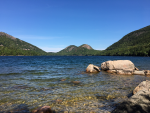
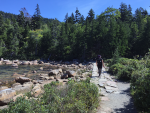







Salem, Massachusetts
After Acadia, we drove the last leg of our road trip heading south to Salem, Massachusetts. Taking time we stayed along the coast and passed through Essex County aka Lovecraft Country. Things have changed a lot since ol’ Howie’s day, but we hunted down (roughly) the location of the fictive Innsmouth near Essex Bay. It’s charming. Rural in some places, built up in others. The towns and small farms are picturesque. It lacks much of the foreboding and uneasiness one would expect reading Lovecraft’s writings—even with the summer thunderstorms passing overhead. But I can see the appeal. A lot of history in that part of the country.
[image error]The Witch House in Salem, Massachusetts — once the former home of Judge Jonathan Corwin it is the only building with ties to the trials still standing
We arrived at Salem that evening and walked the town wandering through The Burying Point graveyard during a storm which certainly added to the mood. The next day was our last in New England. We opted to stay in Salem since it was near the airport and was full of all sorts of weirdness. On the more serious side, we visited the House of the Seven Gables and the Salem Maritime National Historic Site. Both were excellent.
Longtime readers know that I’m a sucker for history and both Kari-Lise and I love roadside attractions. So, of course, we took the opportunity to visit some of the goofier museums in the area. There’s plenty of both to be found in Salem. It seems like every corner has some museum willing to spin you their version of the Salem witch trials. We hit up two: the Witch Dungeon Museum and the Witch History Museum. Both had that bizarre dated feel that I love. You know the type: disjointed narratives presented in a dim room filled with lovingly crafted mannequins that haven’t been dusted in decades. Both told the tragic story of the Salem Witch Hunts, and both tried hard, but the life-sized dioramas from the 70s made the whole thing feel silly rather than serious. Luckily, they paled in comparison to our walking tour with a local guide named Jeff. His knowledge of the area was impressive, and his tour opened up the story in a way the museums can’t achieve. He has an intimate understanding of the stories of the victims, and he really made the tragedy feel more alive. It was an excellent cap to our time in Salem. The next morning we packed up and made our way to the airport for an early flight home.

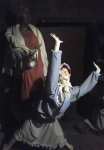
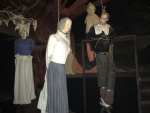
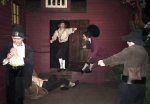
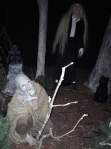
The United States is enormous and there’s as much to see here as there is in the wider world. Unplugging from the internet and the news cycle was refreshing. Mentally living in the moment had a recentering effect. Coming back really put the drama on social media and in the twenty-four-hour news cycle into perspective. It all feels so small and so much of it is incredibly petty.
It was a fantastic little trip. Much fuller than I had anticipated. Celebrating a wedding, visiting a national park, and delving into some history was an excellent way to spend a week. The weather worked against us a few times, but it was good to go beyond Boston and explore the countryside.
Travel is energizing for me creatively, but it’s good to be back home. Autumn is quickly settling into Seattle, the nights grow longer, there’s a crispness to the air, and the rains have returned. And, as always, I have books to write.
 Want to stay in touch with me? Sign up for Dead Drop, my rare and elusive newsletter. Subscribers get news, previews, and notices on my books before anyone else delivered directly to their inbox. I work hard to make sure it’s not spammy and full of interesting and relevant information. SIGN UP TODAY →
Want to stay in touch with me? Sign up for Dead Drop, my rare and elusive newsletter. Subscribers get news, previews, and notices on my books before anyone else delivered directly to their inbox. I work hard to make sure it’s not spammy and full of interesting and relevant information. SIGN UP TODAY →
September 10, 2018
Raunch Reviews: Harry Potter
Raunch Reviews is a series about profanity. Not real profanity, but speculative swearing. Authors often try to incorporate original, innovative forms of profanity into our own fantastical works as a way to expand the worlds we build. Sometimes we’re successful. Often we’re not. In this series, I examine the faux-profanity from various works of sci-fi and fantasy, judge their effectiveness, and rate them on an unscientific and purely subjective scale. This is Raunch Reviews, welcome.
[image error]The Author: J. K. Rowling
Work in Question: The Harry Potter Series
The Profanity: “Mudblood”
One of the many duties of successful speculative fiction is to work as a mirror on reality, and ultimately, humanity. Sometimes that mirror can reflect more serious subjects. So, it’s no surprise that something like bigotry would become a topic, even in a series like Harry Potter. While there have been a great many articles written about the successes and failures of the metaphor, the goal here is to examine the word itself.
Enter “mudblood.” It is a slur for a magical person born of parents who have no magic ability of their own. Considered highly offensive, it gets slung around a lot in the series by bullies, villains, and the propaganda arm of the fascist state. Clearly coded like racial profanity, the word is designed to dehumanize (or dewizardize, in this case), and the connotations manifest throughout the series. In fact, the entire story across all seven books largely consists of the titular hero and his pals battling against a villain who believes all of wizardkind should be “pure-bloods.” (We can trace this back to Salazar Slytherin—the goth racist who founded Slytherin House and thought the school should only teach those of pure wizard-blood. Then he left when no one agreed with him. He was basically the Morrissey of Hogwarts.) It’s important to recognize the context of “mudblood” in relation to the overall struggle; it’s not just a word bandied about by meanies, it has plot connotations as well.
As a term, it’s evocative of modern racial profanity. Used within the realm of speculative fiction, it does its part to hold up the mirror, and as faux-profanity it does this effectively.
Score: [image error][image error][image error][image error][image error] (4.5)
Previous Raunch Reviews
“Frak” from Glen A. Larson’s, Ronald D. Moore’s, & David Eick’s Battlestar Galactica
“Jabber” from China Miéville’s Bas-Lag
“Storm it”/”Storms”/”Storming” from Brandon Sanderson’s The Stormlight Archives
Have a suggestion for Raunch Reviews? It can be any made up slang word from a book, television show, or movie. You can email me directly with your recommendation or leave a comment below. I’ll need to spend time with the property before I’ll feel confident reviewing it, so give me a little time. I have a lot of books to read.
[image error]
September 3, 2018
The Union Forever
August 30, 2018
Quick Hiatus
For the next ten days or so I will be intentionally incommunicado with this blog and the rest of the internet as a whole. Responses to emails and comments will be delayed. Kari-Lise and I will be traveling to New England, where we will be attending a wedding, visiting a National Park, and where I hope to eat a lobster roll (or seven.) I might occasionally post to Instagram, so if you’re not following me over there, feel free.
There are quite a few posts in the hopper (including one already scheduled.) My current plan is to resume normal blog activities around mid-September. If you’re looking for something to read here in the interim, here are a few of my more popular posts over the last few years:
Your Fave is Problematic—That’s Okay
Mapping Resources for Authors (and GMs)
Raunch Reviews: Battlestar Galactica
A Riverboat’s Demise
How Passenger Airships Worked
Hunting The Yellow Sign
Mad Max: Fury Road and the Art of Worldbuilding
August 25, 2018
The Struggle
[image error]
Social life? What’s a social life? This week I’m really feeling this animated version of the classic “pick two” puzzle. It comes from illustrator/designer Gal Shir. You can see more of his work at his Dribbble page and at galshir.com.
Okay, back to it: words, writing, chapters.
August 24, 2018
Alive at Once
“The significance of a myth is not easily to be pinned on paper by analytical reasoning. It is at its best when it is presented by a poet who feels rather than makes explicit what his theme portends; who presents it incarnate in the world of history and geography, as our poet has done. Its defender is thus at a disadvantage: unless he is careful, and speaks in parables, he will kill what he is studying by vivisection, and he will be left with a formal or mechanical allegory, and what is more, probably with one that will not work. For myth is alive at once and in all its parts, and dies before it can be dissected.”
August 23, 2018
Visual Inspiration: Filip Dujardin
Often when I share an artist that’s been inspiring to me, it’s usually someone who works as a concept artist. Today’s entry will be a bit of a departure from that. Filip Dujardin is a Belgian photographer who manipulates photos of architecture and cityscapes to create beautiful photomontage works that question the notion of architected spaces.
“I want to play at being an architect. All my creations leave the impression that they could have been built, it’s just that you’ve never seen them.”
—Filip Dujardin
In many ways, I think of my own work—and Lovat in particular—as a love letter to cities. Even if it’s just tangentially. There’s something fascinating about the constructed spaces and interactions that happen within. I love the optimistic concept of the city and the unpleasant realities that dwell in the shadow of that idealism. I find those juxtapositions beautiful. Many of those same themes are present in Dujardin’s work, in particular, his Fictions series. The interplay of form and function both natural and unnatural are warped and distorted, and it gives me pause as a viewer. I’m forced to reflect on the nature of urban environments and our interplay with them as occupants—what they mean, what they remove, how they shape us, and how they distort our experiences and change our perceptions.
I’ve selected some of my favorites below. Click to view them larger.
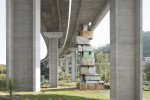











This is just a tiny sample of Filip Dujardin extensive body of work. You can see much more in his book Fictions and over on his website. (Be sure to check out his Guimaraes series.) If you’re looking to purchase any of his pieces, many are available online at Artspace.com.
If you like Filip Dujardin’s work be sure to check out some of the other artists who I’ve found inspiring in the past. While there’s certainly a theme to the art that inspires me, you’ll find lots of different styles, tones, and moods.
Sebastien Ecosse
Zhichao Cai
Yuri Shwedoff
Jordan Grimmer
Kuldar Leement
Marc Simonetti
Anthony Wolff
Robin Olausson
 Want to stay in touch with me? Sign up for Dead Drop, my rare and elusive newsletter. Subscribers get news, previews, and notices on my books before anyone else delivered directly to their inbox. I work hard to make sure it’s not spammy and full of interesting and relevant information. SIGN UP TODAY →
Want to stay in touch with me? Sign up for Dead Drop, my rare and elusive newsletter. Subscribers get news, previews, and notices on my books before anyone else delivered directly to their inbox. I work hard to make sure it’s not spammy and full of interesting and relevant information. SIGN UP TODAY →
August 22, 2018
Well, My Interest is Piqued
I don’t play many video games these days. I find it difficult to get engaged the way I was in the past, so I can’t rightfully call myself a gamer. However, when I saw the recent cinematic trailer for Frogware’s The Sinking City, I can’t deny it caught my attention. It was the right mix of tone, style, and weirdness paired with Lovecraftian cosmic horror. I’ve posted the trailer below so you can check it out for yourself.
How about that setting? The Sinking City currently being billed as an “open world, open story, investigation game inspired by H.P. Lovecraft” and that’s enough to keep me interested. I’m wildly bored with combat-focused titles, so the investigation angle sounds appealing. How about you?



